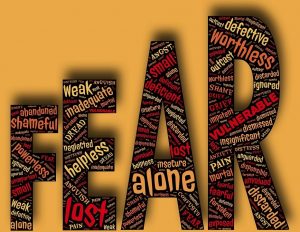7.1 Anxiety Disorders

We all experience some level of anxiety, for example when driving through the orange barrels during road construction, or if you are pulled over by the police for speeding (I know none of you have ever exceeded the speed limit :), or when you start a new job, have an exam or meeting someone for the first time. Anxiety can also motivate you to prepare more, brush up on your interviewing skills, or feeling anxious before your wedding. Anxiety is a normal part of life.
What’s the difference between “normal anxiety” and when someone is diagnosed with an anxiety disorder? A person diagnosed with anxiety disorders reports frequent, intense, excessive and persistent worrying while feeling fearful about everyday life situations. Many individuals have/will report intense repeated episodes of fear and terror, causing chest pains which are panic attacks. These panic attacks disrupt a person’s ADL’s (Activity of Daily Living) and are difficult to manage and live with. Do you know where most panic disorders are diagnosed? The Hospital. When a person is experiencing a panic attack, they report “I can’t breathe, I feel like my heart is going to jump out of my chest.” Once an individual presents to a medical professionals several times (usually in the emergency room), the attending physician will say, “there is nothing wrong with your heart, what you may be experiencing is a panic attack”, while referring them to either the person’s PCP or a recommendation to see a psychiatrist.
In this classification of Anxiety Disorders there are eleven different diagnoses and several important points to understand. All of the anxiety disorders share a common feature, excessive fear, anxiety and related behavioral disturbance. (DSM V, p. 189) Fear is the emotional response to a real or perceived imminent threat, whereas anxiety is anticipation of future threat. Please read page 189-190 in your DSM V for an overview of anxiety disorders.
As we discussed earlier, the American Psychiatric Association created this DSM V manual to address the diagnoses as they are identified in the life span of an individual. This classification is no different. The way this classification is set up, starts with the disorders sequenced according to the “typical age” at onset.
Activity
Choose one of the anxiety disorders below and read about your chosen disorder. Upon completion in your own words write a three page paper that includes the following:
1) Through understanding of your chosen diagnosis, in your own words: how would you explain your diagnosis to a client?
2) Research and describe two clinical interventions that you could use to ameliorate the reported symptoms
3). Identify 2 goals that you and your client would work on.
Assessments
There are a variety of assessments to utilize that will assist you to measure symptoms of anxiety in both children and adults. With that being said, each diagnosis has specific assessments to be used, which is beyond the scope of this OER.
Separation Anxiety Symptom Inventory–15 item self-report by adults 18 and older
Adult Separation Anxiety Checklist–Self-report questionnaire
Beck Anxiety Inventory–Quick assessment for Adults
Multidimensional Anxiety Scale-Designed for children 8-18, it has 39 items scaled
Self-Reported Level 1 Cross-Cutting Symptoms Measure-Adults
LEVEL 2—Anxiety—Adult**PROMIS Emotional Distress—Anxiety—Short Form
LEVEL 2—Anxiety—Parent/Guardian of Child Age 6-17**Adapted from PROMIS Emotional Distress—Anxiety
LEVEL 2—Anxiety—Child Age 11–17**PROMIS Emotional Distress—Anxiety—
Clinical Interventions/Strategies
Cognitive Behavioral Therapies are evidence based interventions that have been known to be successful in treating Anxiety Disorders. With that being said, each of one of the disorders in this classification also have a variety of other interventions and strategies to use. To address all of the different interventions are beyond the scope of this book.


